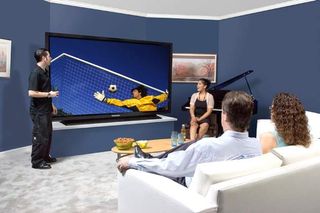New Super-Size TVs: Action Larger than Life

Don’t want to be squinting at your TV screen during the Super Bowl? Perhaps you’d be happier with one that’s about 4 feet by 8 feet. In close-up shots, the players will be larger than the people in your living room. The effect of wide shots is like looking out a large window.
This experience can be yours for about half the price of a small house in some suburbs.
Panasonic announced a 103-inch (diagonal measurement) flat-panel TV last year that in December officially went on sale in the United States, with a product code (TH-103PZ600U) and a suggested retail price of $69,999.95. They’ve sold several, including one to billionaire Mark Cuban, and two to NBC for use on the set of a sports program. Weighing nearly 500 pounds, they take a fork-lift to move and require professional installation—but you can probably hold out for free delivery [see the TV].
Actually, Panasonic was obviously just trying to one-up Samsung, which had earlier come out with a 102-inch unit. Raising the ante in early January was Sharp, which answered Panasonic by coming out with a 108-inch unit.
- Super Bowl Hightlights Available on iTunes
Where can this end?
Actually, with the Sharp announcement the size war may have ended, Kurt Scherf, home entertainment industry analyst at Parks Associates in Dallas, told LiveScience.
Scherf said the flat-panel TV world is split between competing camps that use LCD and plasma technology, and the plasma camp formerly had an edge in its ability to make larger units. The Samsung and Panasonic units were plasma panels. But the new king of the hill, the 108-inch Sharp unit, is an LCD panel, signaling that the LCD camp has caught up.
Sign up for the Live Science daily newsletter now
Get the world’s most fascinating discoveries delivered straight to your inbox.
“Where mainstream consumers are looking for their TVs is square in the 36- to 50-inch range,” Scherf said. “The only reason to make them bigger is for validation.”
- Who Invented the TV Dinner?
On the other hand, “There’s a constant race to make bigger and bigger display panels, because being able to make bigger panels drives down your production costs,” said Steve Wilson, an analyst at ABI Research in Oyster Bay, NY. “You can chop them up to make moderate-sized TVs, or you can leave them intact and someone might buy one.”
Sharp's unit was on display at the Consumer Electronics Show in Las Vegas in early January.
“What were they talking about at the Consumer Electronics Show? Sharp’s huge TV,” said Eric Haruki, research director at IDC, a market research firm in Framingham, MA.
“Having the biggest creates buzz, and puts your brand on top of my brand—that’s 90 percent of the reason for making them," Haruki said in a recent telephone interview. "But the other 10 percent is a legitimate business venture—they do sell them."
- Blog: Einstein, HDTV, and the Error You Just Made
- Fourth and Goal: NFL Coaches Make Lousy Decisions
- Super Bowl Ad Warns of Heart Attack Risks
- Football's First Forward Pass
